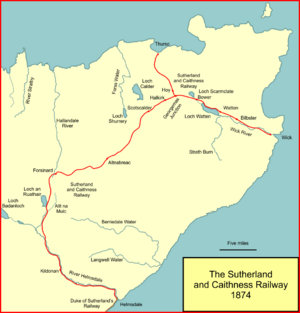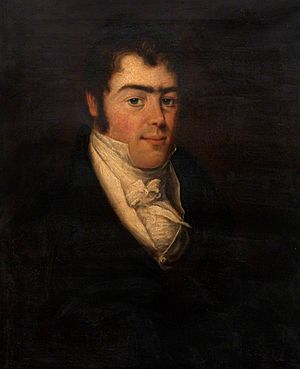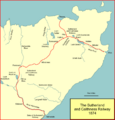Sutherland and Caithness Railway facts for kids
| Overview | |
|---|---|
| Locale | Scotland |
| Dates of operation | 28 July 1874–30 July 1884 |
| Successor | Highland Railway |
| Technical | |
| Track gauge | 4 ft 8 1⁄2 in (1,435 mm) |
The Sutherland and Caithness Railway was a railway company in Scotland. It built a train line that connected the towns of Wick and Thurso in Caithness to the rest of the Scottish railway network. This allowed people and goods from these northern towns to travel to places like Inverness.
The railway was built thanks to the hard work of the 3rd Duke of Sutherland and an engineer named Joseph Mitchell. They faced challenges, including difficult land and some people in Wick who weren't keen on the idea. The line opened in 1874. Today, it is still used as the northern part of the Far North Line.
Contents
Why the Railway Was Needed
For a long time, people in Inverness wanted railways to go further north. The Inverness and Ross-shire Railway reached Bonar Bridge in 1864. Then, the Sutherland Railway made it to Golspie by 1868.
After that, the Duke of Sutherland used his own money to build the Duke of Sutherland's Railway. This line opened to Helmsdale in 1871. North of Helmsdale, the land was wild and had few people. But at the very top of mainland Scotland were the important towns of Thurso and Wick. They needed a way to connect to the south.
Early Plans for a Caithness Railway
Before the Sutherland and Caithness Railway, there was a plan for a "Caithness Railway." This company wanted to build a line just between Wick and Thurso. It would not connect to the lines coming from the south.
In 1866, Parliament gave them permission to build it. However, they couldn't find enough people to buy shares in the company. This meant they didn't have enough money to build the railway.
In 1864, people in Caithness started talking about a railway. The Earl of Caithness formed a group to promote a line that would join the railway coming north from Inverness. They asked engineer Joseph Mitchell to survey a route from Helmsdale to Wick and Thurso.
Mitchell found that the Ord of Caithness mountains north of Helmsdale were a big problem. He suggested a route that went around the mountains to the north-west. This route would be longer but cheaper and easier to build. It would also open up new areas for farming.
However, some people in Wick wanted the shortest route possible to the south. This meant a coastal route over the Ord. This idea was very difficult. It would have needed a steep climb and even a rope-pulled section. Luckily, this dangerous plan was dropped.
Money Problems and New Plans
Raising money for Mitchell's route was hard. People in Wick were happy with their ships for transport. They didn't want to pay for a railway that would help other areas. A railway builder named Thomas Brassey offered to help. He said he would build the line and take some payment in shares. But a lot of money was still needed.
The Duke of Sutherland even stopped his financial support for a while. The Caithness Railway company got permission for their "local line" in 1866. But they only raised a small amount of money. They simply could not build their railway.
When the Duke of Sutherland’s Railway reached Helmsdale in 1870, it spurred new action. The Caithness Railway directors decided to try again. They wanted to build a line from Helmsdale to Wick and Thurso, similar to Mitchell's original idea. But they still didn't have a clear way to get the money.
The Duke of Sutherland then decided to promote his own similar line. This was the Sutherland and Caithness Railway. In 1871, both the Caithness Railway and the Duke's new company asked Parliament for permission. Parliament looked at both plans. On July 13, 1871, the Sutherland and Caithness Railway was approved. The Caithness Railway's plans were rejected.
A Different Idea: Narrow Gauge
During the planning, the Duke of Sutherland thought about building a "narrow gauge" railway. This means the tracks would be narrower than standard tracks. A narrow gauge line would be cheaper to build and run.
However, there was a big problem. If the tracks were narrower, goods and passengers would have to be moved from one train to another at Helmsdale. This would be a lot of extra work and time. So, the idea of a narrow gauge line was dropped.
The Duke of Sutherland later said he wished he had known more about narrow gauge railways earlier. He had spent a lot of money on his railways. He believed that if they had been narrow gauge, they would have cost less. This would have helped him get his money back.
Building the Sutherland and Caithness Railway
The new railway line to Wick stopped just outside the town. The branch line to Thurso also stopped at the edge of that town. This meant they didn't reach Wick harbour or Scrabster pier, which was a problem.
Once again, the Duke of Sutherland provided money. He put £60,000 into the new line. The Highland Railway also promised £50,000. It's interesting to note that not a single shareholder came from Wick.
Around 400 to 560 men worked on each main part of the railway. Many of them were local people. They were so dedicated that they even paid for a preacher to visit them on Sundays. Houses for the railway workers were built early to give them places to live.
Building the railway was tough. For about 12 miles, from the County March to Dorrery, the workers had to deal with huge areas of soft peat moss.
The Duke of Sutherland himself drove the first train along the new railway. He drove his own locomotive, named Dunrobin, into Wick station on July 9, 1874. This was just two days after the last rails were laid. The local leaders in Wick came to greet him, but the welcome was quiet. This was because no one from Wick had bought shares in the railway.
His train then went to Thurso. About three thousand people were waiting there, along with two bands. A big dinner was ready. The Duke was the guest of honor, though he seemed a bit shy about it. Sir Tollemache Sinclair had collected money to give the Duke a gift. But the Duke said he had enough silver. He asked for the money to be given to the "poor fellows" who had worked so hard on the line.
The railway was checked by Colonel Rich on July 20. He was happy with it. The official opening was set for Tuesday, July 28, 1874. The first train heading south left Wick at 5:10 a.m. that day. There were no cheers, and only about 70 to 80 passengers.
Joining the Highland Railway
The Sutherland and Caithness Railway joined with the Highland Railway on September 1, 1884.
Railway Stations
Here are some of the stations on the Sutherland and Caithness Railway:
- Helmsdale; this station was already part of the Duke of Sutherland's Railway. It opened in 1871.
- Kildonan; opened in 1874; it is still open today.
- Kinbrace; opened in 1874.
- Forsinard; opened in 1874; it is still open today.
- Altnabreac; opened in 1874; it is still open today.
- Scotscalder; opened in 1874; it is still open today.
- Halkirk; opened in 1874; closed in 1960.
- Georgemas Junction; opened in 1874.
- Bower; opened in 1874; closed in 1960.
- Watten; opened in 1874; closed in 1960.
- Bilbster; opened in 1874; closed in 1960.
- Wick; opened in 1874.
Thurso Branch Line
This was a separate line that branched off to Thurso:
- Georgemas Junction;
- Hoy; opened in 1874; closed in 1965.
- Thurso; opened in 1874; it is still open today.
The Wick and Lybster Light Railway also connected at Wick from 1903 to 1944.
Current Use
Today, the old Sutherland and Caithness Railway line is part of the Far North Line. This line runs from Inverness to Wick and Thurso.
Images for kids





